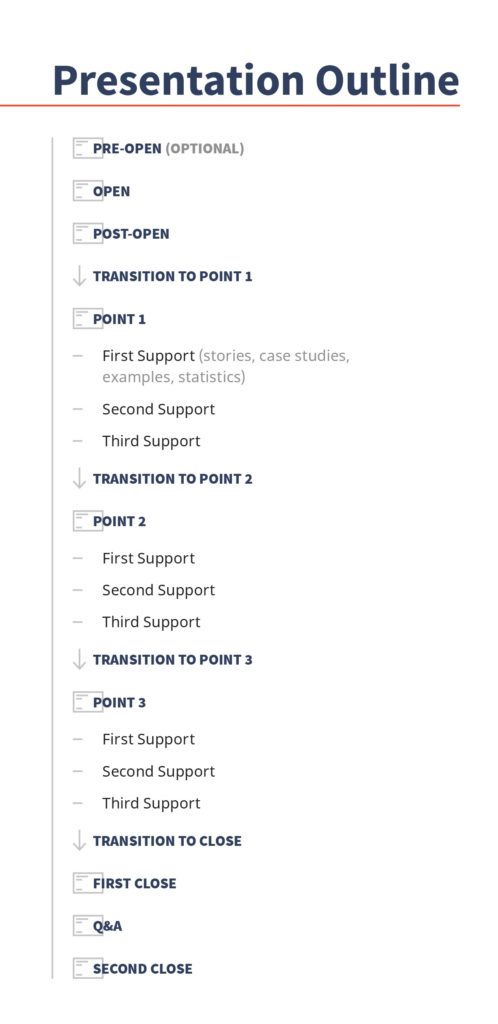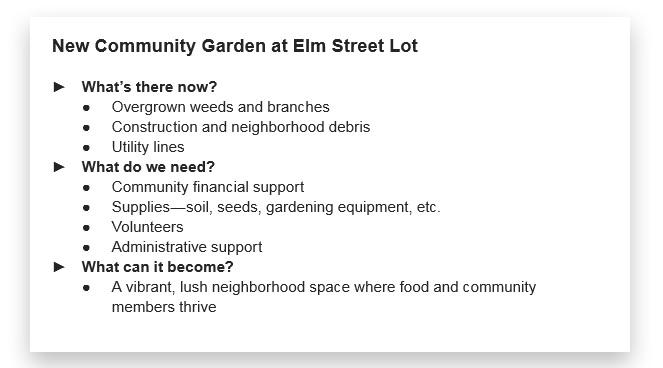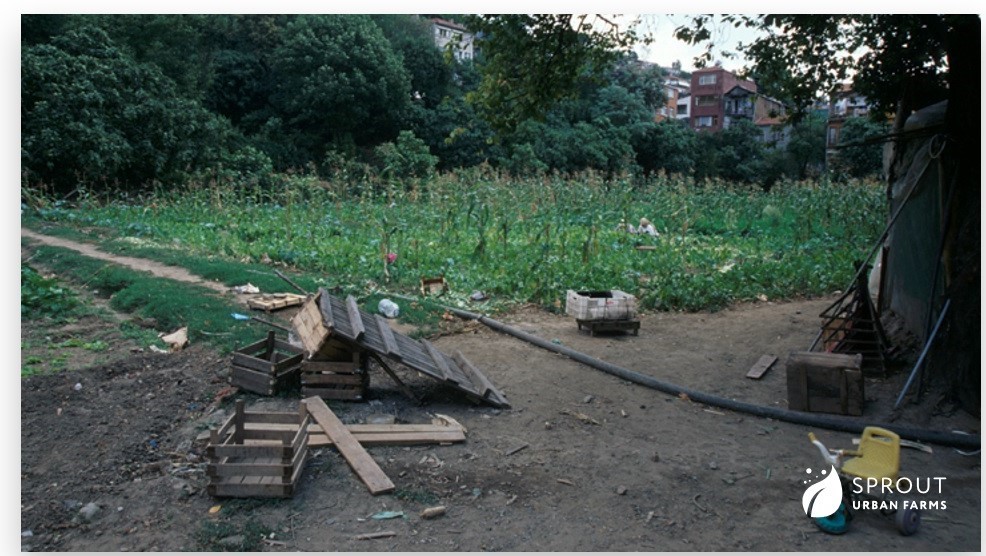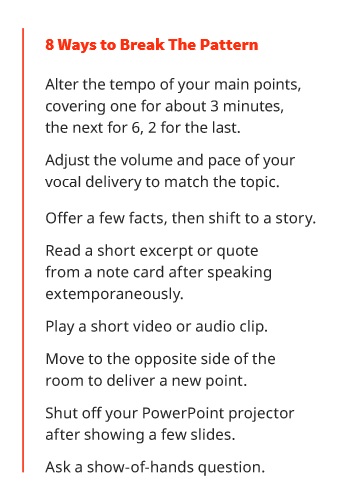First off, we here at Throughline want to release you from the notion that you must be a perfect speaker. These public speaking tips are not a guide for a perfect presentation. It’s a guide for a successful one.
Think about it: The right words at the right time delivered in the right way open a world of possibilities. This is not a platitude, but, rather, a formula that works. Effective speakers inspire others to donate money toward charities, persuade communities to launch new initiatives, attract customers to products they deeply believe in, enhance their reputation as experts in their field, and encourage audiences to think big.

11 Steps to a Successful Presentation
In this guide, we offer 11 steps that take you from initial concept to final word and beyond. Along the way, you will discover how to more effectively communicate with the audiences that matter most to you. We offer public speaking tips about beginning your presentation, incorporating visuals, and keeping your audience’s attention, along with many others. As we do in our public speaking training sessions, we will guide you in how to steady those jitters, connect with your audience and conduct an effective Q&A.
You will become a better speaker through these commonsense approaches. When you deliver powerful words and visuals with a confidence that you feel, as well as project, you create an experience that is memorable and enduring for you and your audience.
Whether you are new to public speaking or a seasoned pro, the right public speaking tips at the right moment can bring about transformational change. We have seen it happen time and time again.
Ready to get started? Let’s begin.

Step 1: First There Was Light
But where to begin? Is your mind a blank page or a mishmash of ideas that resembles a mad jumble of sticky notes? Do yourself a favor — for your sanity and the sake of your audience — and boil your key point down to its core.
“How,” you ask, “do you do that?” By answering this:
If there’s just one headline, one idea or one takeaway message that your audience remembers three months from now, what do you want it to be?
There you have it — the spark of illumination that will guide you on your way. We call this your BSO, or bright shiny object. Its luminescence is ever-present through your presentation, an unmissable beacon that keeps drawing the audience to your main point.
Say you are an urban farmer who wants residents to get behind an effort to turn a neglected lot into a community garden. Your BSO could be:
“I can see the flowers through the weeds. With imagination and hard work, I believe we can turn this abandoned lot into a thriving community garden.”
But you want to share this bright shiny object. We call this transforming your BSO into an ABSO, or audience-focused bright shiny object. As the acronym implies, the audience is imperative to this exercise. So, get to know your audience and think about what attitudes, values, or worries they hold, particularly those that diverge from your message. Think about how you can modify your BSO, even subtly, so it aligns seamlessly with their greatest concerns. You want them grabbing that conceptual swag bag, your ABSO, on the way out the door. You don’t want them leaving it on the table.

Here are a couple of questions you might ask:
Are they supportive of your mission?
If so, here’s your ABSO: “I know you can see the flowers through the weeds, as I do. As a neighborhood, we will tap our collective imagination, donate time and money, and work tirelessly to transform this lot into a community garden. In doing so, we will create a spot for neighbors to gather, children to learn, and a community to grow.”
Are they supportive, but hesitant about the time and effort?
Try this: “Today, I will address your concerns about this community garden project. Yes, it will take money and time. But, more than anything, I hope to show you that transforming this abandoned lot into community gardens will provide a gathering space where plants, and members of the neighborhood, will thrive.” Now that you have your ABSO, it’s time to share it. Before you can convince your audience to buy into your presentation, however, you need their attention. We’d like to introduce you to your opening.

Step 2: Attention Please!
Back when salespeople traveled the countryside peddling wares, they would set up shop by raising a bold-colored tent to attract the curious. Once they got prospective customers in the tent, they had mere moments to offer the compelling pitch that would keep them there. While we know you are not selling magical potions or brushes, we do know that the psychology behind this approach works for selling your ideas to your audience.
An opening should be engaging and on message — that means your ABSO — with attention paid to the first few minutes. John Medina, a developmental molecular biologist and author of Brain Rules, refers to this time as “cognitive hallowed ground.” He writes:
“If you are trying to get information across to someone, your ability to create a compelling introduction may be the most important single factor in the later success of your mission.”
No pressure here, however, and we mean it. Even with such high stakes, there are many successful ways to open a presentation. We covered many in our book 101 Ways to Open a Speech.
Here are three of the most popular:
The Summary Open
The most direct, it tells audiences what topics you intend to cover and how you will cover them. It follows the concept of “tell them what you’re going to tell them, tell them, then tell them what you’ve told them.”
The First-Person Anecdote Open
A compelling approach, it presents your bright shiny object in personal terms, which can create an immediate connection with the audience.
The Surprising Statistic Open
Most raw numbers don’t stick unless they are set in a more meaningful context. With this option, you do just that. Say your talk is about encouraging people to take small steps toward better health. You might start like this: “How long do you think it takes to exercise daily to see cardiovascular improvement? Sixty minutes? Thirty minutes? It turns out a recent study found that exercising just 10 minutes a day led to a near-immediate benefit for a group of sedentary women.’”
Here’s another that could work well for our urban farmer. We call it the Newscaster Tease Open, since it’s modeled off a presentation skills technique used by many news programs. They throw out a hook before a commercial break to reel you back. Here’s the opener:
“Recently, you may have noticed a new shed in the abandoned lot on Elm Street. Today, I am going to talk about other surprises that soon will appear in that corner of the neighborhood, the three donors who gave an unexpectedly generous donation, and why this effort has captured the attention of the governor’s office.”
Now it’s time to tell the rest of the story.
Step 3: As I Was Saying …
Several years back, federal researchers discovered that about 49 percent of U.S. adults eat at least one sandwich per day. Given the finding, and our own anecdotal experiences, we suspect most people have made at least one sandwich, and, undoubtedly, a whole lot more. Sure, there are days when a simple sandwich suffices. Then there are days when nothing but a triple-stacked taste creation will do. What type of dish do you want to offer your audience?
 We’re guessing that you want to build a craft sandwich, not some assembly-line sub.
We’re guessing that you want to build a craft sandwich, not some assembly-line sub.
First, we’ll cover the basic recipe for a traditional talk (see outline at right), and then we’ll start stacking.
Following your opening is the main body of your talk. Generally, three main points work best, with each bolstered by stories, including case studies and examples, as well as statistics. These secondary points add context and depth to your main ideas. If we use the analogy of the sandwich, the meats are your main points, while the veggies, cheeses, condiments and spices are your supporting materials. Between each point, there should be a transition (that extra layer of bread), which provides a pivot from one section to the next. A transition links the thought before it to the one that follows.
You won’t be building your presentation with deli meats, so here’s a sample structure of the flow of your presentation in outline form (see sidebar). This is the most common approach used by public speakers, as it is flexible and can adjust to your subject and supporting materials.
Let’s return to that community garden. For your first main point, you shared details about the new shed and the local businesses that donated it and other supplies. As you move to your second point, you could say:
“As you have learned, many businesses have put their money where their mouths are and pledged their support. This seed money will help us to attract more donations and encourage volunteers to get involved. I now want to let you know what specifically is needed to allow this initiative to take root.”
Here’s our transition: Now that you know about your opening and the body of your speech, we move to some public speaking tips that will help you make a successful close.

Step 4: The Closer
Sprinters don’t let up on their speed as they approach the finish line. They turn up the heat. Speakers need to employ the same energy to their final words. This is your last chance to make an impression, inspire your audience, move them to action, or change their perspective.
As with your opening, your closing should be engaging and on message. Many presenters either mumble a hasty goodbye or meander among many final thoughts on their way to obscuring the brilliance of that ABSO. Here are several ways to share your final thoughts:
The Summary Close
This approach recaps the main points of your presentation and represents the “tell them what you’ve told them” part of the “tell them what you’re going to tell them, tell them, then tell them what you’ve told them” concept that you introduce in a Summary Open. As a close, it is a useful reminder and ensures the audience leaves with clarity on your most important points.
The Personal Close
If you didn’t employ an anecdote at the beginning, you can at the end. As your final thought, it can be a powerful way to strengthen your connection to the audience.
The Next Steps Close
This option offers a sequence and timeline of next steps required to arrive at a decision or attain a goal.
In the pitch for the community garden, a “forward-looking” close is an effective one. Here’s the example:
“Some only see the clutter, trash, and weeds that have taken over the Elm Street lot. What I see is a time, in the not-so-distant future, when flowers bloom, vegetables grow, and community volunteers enjoy the fruits of their labors. It can be done. Two years ago, in a city not 10 miles from here, a garden rose from a lot many thought unredeemable. It now attracts bees and butterflies, as well as dozens of aspiring gardeners who are creating a pocket of green where there was once only dirt and debris. It is my hope you also can see the flowers through the weeds.”
As this close suggests, one of the more powerful tools for a speaker is visualization. If the audience imagines it can happen, they are more likely to make it happen. Next, we’ll suggest ways to use actual images — photographs, illustrations, and PowerPoint slides — to get your message to stick.
Step 5: Show, Don’t Tell
Close your eyes. Now, imagine an iconic photograph of the past 100ea yrs. Is it the 1954 photo of Marilyn Monroe and her “flying skirt” as a subway passes under the grate below her? Is it Neil Armstrong’s 1969 picture of fellow astronaut Buzz Aldrin on the moon? Did you think of Muhammad Ali, jubilant over his first-round knockout of Sonny Liston in the 1965 World Heavyweight Title fight? If you are a Chicago Cubs fan, perhaps it might be any and all photos taken following the Cubs win over the Cleveland Indians in Game 7 to win the 2016 World Series.
Maybe you thought of none of these images, but you are thinking about them now. That’s the lasting power of an image. It can tell the whole story or part of the story, enhance a story, or draw you into a story.
As a presenter, you have many visuals from which to choose. You can go old school with a simple pad, easel, and marker. You can employ audio or video clips. If you are launching a new product or invention, you can try a dynamic demonstration. Many presenters use PowerPoint for part of or their entire presentation.
However, all visuals start with an idea. Images lose their punch when utilized as reminders for the words you want to share, rather than visual concepts that enhance your main theme for the audience. For instance, it is not particularly effective to project a slide with a list of four points and then read them verbatim to the audience. The right visual with the right idea will reinforce and strengthen your message.
We’ll go back to our urban farmer. She could use a typical “words and bullets” slide to convey information, a type of slide you’re undoubtedly familiar with.

Happily, she has decided to punctuate her closing remarks with photos instead. Her first is an image of the lot that she is discussing, with its overgrown weeds and debris.

Next, she shows a slide of a photo of that garden 10 miles away, which, after a similar renewal effort, is now a vibrant, lush, and beautiful gathering place.

Even without words, two of her messages come through loud and clear — volunteers can make a difference, and transformation is possible. These images say far more than a slide with dozens of words, numerous bullets and statistics.
All the pieces of your presentation are now in place. In this next step, we bring you the public speaking tips that will bring all those pieces together.

Step 6: From the Top
A hit Broadway production or championship season is rarely a fluke. They more often are the result of weeks of rehearsals and training. While some presentations could benefit from weeks of practice, few speakers have that luxury of time for preparation.
What is more important is the quality of your preparation. Effective practice sessions reveal the soft spots that stand in the way of all your hard work. Listless anecdotes, awkward transitions, distractive visuals, and ineffective pacing are just some trouble spots that can be recognized in advance.
Here’s how you identify and strengthen those weak links, fine-tune your visual delivery, and react to setbacks.
Divide and Conquer
As you rehearse, break up your speech or presentation into smaller segments. Speaking aloud, begin with your opening and first transition and end before you launch into your first point. Move on to the first point and wrap up with your second transition. Begin at Point 2 and continue through to the next transition, so on and so on, until you have covered all your points. Plan for your Q&A (more on that later) and then move on to the close. As you roll through the segments, run a stopwatch to get a feeling for total time. If you run long, look for places to cut. Too short? Add more stories, stats, and facts. Either way, each segment should link to your ABSO.
Break It Up
To use the sandwich analogy, this is the time to ensure a nice mix of ingredients. If you stick to the same old recipe, you lose a chance to wow your crowd. You want to offer unusual taste combinations. In public speaking vernacular, we call this breaking the pattern. If your presentation becomes too predictable, your delivery too monotone, or your movement too static, your audience’s attention likely will drift. Proof of this concept is all around us. Have you ever been sitting in a quiet library, only to be startled by the sound of a loud voice? You probably more easily remember that moment than the very quiet and predictable ones that led up to it. When you think about your presentation, identify the places where you can break out of the predictable. We offer 8 ideas in the accompanying sidebar.
Put It All Together
Now it’s time to run through the entire speech, incorporate your visuals, conduct your demonstration, and treat it as if you are live. If you stumble, go ahead and continue. You can smooth those rough spots on subsequent run-throughs. By persevering, however, you train your brain and emotions to recover from setbacks, which will serve you well during your presentation.
Next up: Before you deliver your presentation, you must decide the best way to share it.

Step 7: Signed, Sealed, Delivered, They’re Yours
Standard. Two-day. Priority. You have choices when it comes to delivery of your postal packages. You similarly have options when it comes to your presentation. A useful shortcut to determine the proper method would be to ask yourself: For this presentation, what’s most important to me: the precision of my words or my connection with the audience?
By precise, we mean you are putting a premium on the words you use and the way you express them. By connection, we mean you are putting a premium on the bond you form with the audience and the way you interact with them. The manifestation of those approaches is likely a script for the first and a more conversational, note-driven delivery for the second.
Other factors, including the presentation’s format (panel versus stand-alone speaker) and the audience’s expectations, will gauge whether a tight script or formal presentation is more appropriate.
Here are several delivery options:
Following a Script
Precise delivery typically works best at more formal occasions, such as commencement speeches, official proclamations, or keynote addresses. If you plan to follow a script, it’s best not to aim for linguistic perfection, but rather conversational engagement. You can do this with less formal language and a warm delivery. Truly express your words rather than just reading them. A heartfelt personal reflection loses its punch when delivered in a monotone, with limited eye contact and no emotion.
- Public Speaking Tips 101 — Mark up your script, so when it lands on the lectern on presentation day, there are many delivery instructions. These notes should remind you when to slow down, when to pick up the pace, or when to change the volume.
Working From Notes
This is the sweet spot between formal structure and conversational tone. Whittle your presentation to a list of points or a condensed outline. It’s OK to include some densely worded sections in that outline, such as quotes, excerpts or transitions, which can be difficult to deliver extemporaneously.
- Public Speaking Tips 101 — Start with a script and edit until you have boiled it down to the words that trigger your memory. Print your notes in large font on paper or notecards, and make sure to number them. Rather than holding them, ask for a side table or stool upon which to place them. This allows for more energy and movement during your presentation, as you are free to roam and return when you need to refer to them.
Speaking From Memory
This approach can be the most casual or most stilted. Yes, you have no notes. However, if you have decided to memorize your entire speech and have no intention of straying from it, you may lose an opportunity to connect with the audience. All that memorization takes mental energy — the same energy you could be using to read the faces of your audience to spot confusion or boredom.
- Public Speaking Tips 101 — The difference between memorization and internalization is volume and approach. With the former, you guzzle it all in and pour it right back out in the exact way and order as you wrote it. Internalization is the process of strategic sipping. You memorize the sequence and main points and deliver them in a steady flow.
Now, put all your presentation materials aside for a moment. In this next step, we address an obstacle that can derail all this preparation. We’re afraid to even bring it up, now that you are well on your way to success. But, we must.

Step 8: Have No Less Fear
Do you get the jitters when you step up to a lectern? Does your heart race when it’s your turn to present at a sales meeting? This is entirely normal. When faced with a difficult decision or situation, we tend to become stressed. That, in turn, leads to anxiety.
Your goal shouldn’t be to eliminate your fear of public speaking but to reduce and manage it. We assure you that it can be done with these public speaking tips. They include physical and mental strategies that have helped our clients. Employ them before and during your presentation, or whenever fear and anxiety make their next visit.
Conscious Breathing
This goes beyond the very vital practice of taking in air for survival. This is the breathing that requires steady attention to inhalation and exhalation. If you have ever been to a yoga class, you know the importance placed on deep abdominal breathing. It reduces stress, can lower blood pressure, and ensures the lowest part of your lungs get their proper fill of oxygen. Here’s an easy way to do it, compliments of Harvard Medical School: Find a quiet and comfortable place. Take a normal breath and then go deeper. Breathe in through your nose, slowly, until your chest and lower belly rise, and your lungs fill. Slowly breathe out through your mouth. Repeat until you feel yourself relaxing.
Movement
The main stress hormone in your body, cortisol, is an important player on presentation day. While cortisol can boost energy and make you more alert, the body only means to employ it for short-term needs. Typically, it overstays its welcome, particularly in times of enduring stress — such as a 20-minute presentation. A good way to reduce its presence is through exercise, particularly aerobic — such as walking, running or climbing stairs. The timing is up to you. Some speakers undertake a strenuous workout hours before presentation, while others make it part of their presentation warmup.
Mental Exercises
The way you think about your performance can make or break all that preparation. There are several exercises you might employ before or even during your talk that will help to reduce anxiety. Here are a few:
You Don’t Have to Be Perfect
A few stumbles or misplaced words will not dismantle a strong foundation. Stay focused on delivering your content with confidence, enthusiasm, and competence. Even great presenters can get flustered. It’s the recovery that sets them apart. Keep moving forward—and, if the glitch is big enough, chuckle over the misstep and move on.
It’s Not About You
Instead of focusing on your fears, think about the audience. Imagine their lives, needs, and concerns. Whatever you are about to tell them has the power to make their lives better or bring about a new perspective. When you start worrying about their fears and their needs, you don’t have as much time or mental space to worry about yours.
The Past is the Past
If you’ve had a speaking experience go awry in the past, you may be carrying scars into your new speaking opportunities. It’s OK to learn from the past; it’s not useful to continue to relive it. Every presentation is an opportunity for a reset. Replace those negative or distorted thoughts with accurate and productive ones.
Your words are in place. Your visuals are set. Your anxiety is in check. Now, you just need the public speaking tips that will help you use your body to send the right message.

Step 9: Your Body is Talking. What is it Saying?
In the time it took you to read the first nine words of this sentence, someone could have formed a first impression of you. So what, you say? Well, researchers have found people can be quite accurate in their initial reading of others. They also form opinions just about as quickly, which are often difficult to reverse.
In a well-known study conducted by the late Nalini Ambady, a professor of psychology at Boston’s Tufts University, students only needed to watch two-second video clips of a group of professors to form similar impressions to the ones drawn by students who were enrolled in their classes for the full semester. Did we mention the clips had no sound?
We have taken most of the past eight steps to show you the importance of your words — and they are important. But the physical manner with which you deliver them adds further layers of meaning. Body language is a powerful tool to shine a spotlight on the ideas that matter most. There also is no greater way to cause disconnect with your audience than to deliver words with actions that don’t jive. What would you make of a speaker grimacing as he or she told a funny story? How would you respond to a presenter who spoke in monotone and slouched over the lectern while remarking that he was “excited” to be there? You would be confused.
On the day of your presentation, what you don’t say will be as important as what you do say. Here are some public speaking tips on how to “talk” with facial expressions, gestures, and movement to create meaningful interaction with your audience.
Talk With Your Tone
Focus on being the most energetic and passionate version of you. Hit the gas and don’t worry if you believe you are topping off at 70 miles per hour. The audience is likely clocking you at 40, since we tend to overestimate energy levels when it comes to our public speaking. When you practice, run a video and see how much energy you really are projecting.
Talk With Your Body
If you are a fan of crime procedurals, you undoubtedly have seen your share of dramatic closing arguments. Rarely do the television lawyers make their persuasive pitch sitting from their chairs. They pace. They pause. They walk toward the jurors. It’s hard to keep your eyes off them. As a speaker, you are not a character in some fictionalized, high-stakes trial, but you are trying to persuade your audience. Take a page from an actor’s practice book. Move about the speaking space. Pause to punctuate your points. Alter your pace and volume to coincide with moments of emphasis.
Talk With Your Hands
We are often asked, “What do I do with my hands?” One option is to place them right down your sides. We know it feels weird, but just know you look absolutely normal to everyone else. You can loosely clasp them in front of your stomach, too. Both choices leave you free to gesture — which is ultimately the best use of your hands. Although fast, undisciplined movements can be distracting, body language experts Allan and Barbara Pease say, “Using hand gestures grabs attention, increases the impact of communication and helps individuals retain more of the information they are hearing.”
Talk With Your Eyes
Don’t be stingy. Most speakers believe they lock eyes with audience members for far longer than is true. An easy formula is this: when looking at your notes, your slides, or any place other than your audience, you should be on pause. Any time you are delivering information, you should be looking at an audience member. You don’t have to linger; a few seconds should do before you move on to your next connection. If you’ve noticed that people often look away when they’re speaking, it’s because word retrieval and eye contact are linked. By practicing your talk and “downloading” your words in advance, you can reduce the time spent searching for words — and increase your connection with the audience.
See the opportunities you miss when you remain static behind the lectern?
The ability to be proficient in nonverbal communication also makes for better interaction with audience members during your question-and-answer session. Let’s lay down a few ground rules, though, before you open it to the floor.

Step 10: Managing Your Audience
You have made it through most of your presentation, and your close is on the horizon. So far, you have shown a genuine desire to educate, inform, instruct, or persuade your audience, as you have landed key points and reiterated that audience-focused bright, shiny object. It would be so easy to wrap it up, deliver your final thoughts, bid your goodbyes, and exit. The idea of opening it to a Q&A seems to be inviting the unpredictable. Fear has just entered the room and is about to take a seat.
Among the public speaking tips we offer is this: You don’t have to take any questions. However, when done well, this part of your presentation can be one of the more memorable and energetic elements. Through their questions, your audience may reveal needs, concerns, lingering confusions, and resistance.
You may be thinking of a runaway Q&A, but there is no reason for it to derail. You have built a solid case, taken the audience’s perspective into consideration, and projected confidence through words and actions. All that doesn’t go away when the hands start to go up.
A way to allay fears is to make a list of questions that are likely to be asked. As you arrive at the answers, think about responding in a way that reiterates your message. It’s a formula that also works for questions that you didn’t expect — and some of those can be thorny. For those, we offer some scenarios and ways to respond. What happens if…
…I’m stumped?
You can always say, “I don’t know, but I’ll find out.” Before you get there, however, you have choices. Don’t be afraid to pause and think about your response. You also could say you want time to think of an answer and will come back to it later. Maybe, you just need elaboration — so ask the questioner to say more. Check in with the audience and ask them to share their insights. Or, tell the questioner what you do know. As an example, the urban farmer is asked whether the dirt in the lot contains contaminants. She could say, “We have yet to conduct tests, but I do know that if anything comes back with dangerous levels, we’ll consider remediations and how that might affect the feasibility of planting for next season.”
…I’m criticized?
Not so much a question as a comment, an audience member delivers a withering, critical analysis of your performance. You, of course, could not disagree more. The rest of the audience is caught in the middle. If you want to elevate your critic to co-presenter, you could trade barbs until one of you breaks. The more effective approach is to strip away the questioner’s negative language, listen for and address their underlying concern directly, and quickly, and move on.
You could also ask your audience to signal if they want to spend more time on the subject. If dozens of hands go up, your critic has done you a favor and shown that there is interest, as well as desire, for more information. The reverse would signal that one person’s perspective is just that.
…I’m challenged?
Let’s just call this one for what you are feeling — attacked. It’s natural to become defensive. You likely fear your credibility for the entire presentation has just been undermined. Don’t dwell there.
This is an opportunity to address what is a valid concern for the questioner and to demonstrate to the rest of the audience that you are direct in your approach. They see a speaker who is not afraid to answer tough questions. Force yourself to slow down and really listen. Next, take an open stance when answering and keep the tone of your voice positive.
Ready to wrap it up?
After you close the questions, it’s time to deliver your final message. As we mentioned earlier, this is the time to make a strong, dynamic run for the finish line. Remember to illuminate the points that matter most and send your audience off with their bright, shiny object. Stay on message as you work to inspire, move them to action, or change their perspective.
Could it be? Yes, you are done. Phew!
Step 11: One Last Note
 Well, not quite. Your last presentation can only make your next presentation better. After your talk, stick around and ask audience members how you did. If the organizers have filmed the presentation, see if you can get a copy. Or, for your next presentation, ask a friend to film you. Then, take time to watch it. Please, be kind to yourself. This is not the time for harsh criticism.
Well, not quite. Your last presentation can only make your next presentation better. After your talk, stick around and ask audience members how you did. If the organizers have filmed the presentation, see if you can get a copy. Or, for your next presentation, ask a friend to film you. Then, take time to watch it. Please, be kind to yourself. This is not the time for harsh criticism.
Did you rumble through your words? Practice your pace. Was your body saying one thing while your words said another? Brush up on your body language. Want to become a better storyteller? Share some tales with your friends and seek feedback.
Look back through these steps and honestly assess where you did well and where you could do better. Pick one or two things to improve upon, employ the public speaking tips that work best for you, and leave the others for another day.
A Successful Presentation — From Start to Finish
We end where we began. Public speaking is not about perfection but persistence. Success occurs with preparation. Growth occurs with practice, whether you are a novice or a seasoned pro. Delivering the right words at the right time in the right way does indeed open a world of possibilities. Transformational change is possible.
We have seen it happen time and time again. And that is our ABSO.
Expand Your Public Speaking Skills
Our public speaking skills training focuses on long-term growth rather than a standalone one-time experience.

 Break It Up
Break It Up